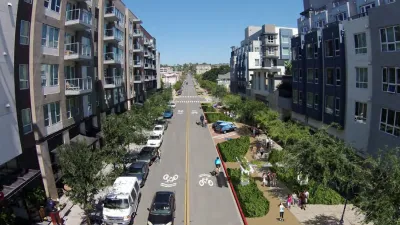As the San Diego Planning Department folds into another department to save city money, locals and former officials grapple with whether it was the right move and how the city could change as a result.
Mixed feelings abound in the city, even from the former planning director who resigned over the merger.
"Until now the city's pro-active planning model has been similar to models used in Boston, Seattle, San Antonio, Austin, and Portland-all cities recognized for effective planning and high-quality urban development. San Diego won awards from the American Planning Association and the Urban Land Institute for its 2008 overhaul of the city's general plan. But in his state of the city address in January, Mayor Sanders claimed that merging planning with development services would "save as much as $1 billion by eliminating duplication."
Bill Anderson, who was the city's Planning Director before resigning in May, sees pros and cons in the new arrangement. "We will benefit by having California Environmental Quality Act issues tied more to development. Also, with the staff for land development code under development services instead of in a separate planning department, things may be more efficient," he said. However, Anderson cautioned, "Now planning becomes a more conventional regulatory process, rather than a pro-active community planning and development department." Currently a principal and vice president at AECOM, Anderson left his position with the city largely because of the impending merger."
FULL STORY: Down with the Plan?

Alabama: Trump Terminates Settlements for Black Communities Harmed By Raw Sewage
Trump deemed the landmark civil rights agreement “illegal DEI and environmental justice policy.”

Planetizen Federal Action Tracker
A weekly monitor of how Trump’s orders and actions are impacting planners and planning in America.

The 120 Year Old Tiny Home Villages That Sheltered San Francisco’s Earthquake Refugees
More than a century ago, San Francisco mobilized to house thousands of residents displaced by the 1906 earthquake. Could their strategy offer a model for the present?

Ken Jennings Launches Transit Web Series
The Jeopardy champ wants you to ride public transit.

BLM To Rescind Public Lands Rule
The change will downgrade conservation, once again putting federal land at risk for mining and other extractive uses.

Indy Neighborhood Group Builds Temporary Multi-Use Path
Community members, aided in part by funding from the city, repurposed a vehicle lane to create a protected bike and pedestrian path for the summer season.
Urban Design for Planners 1: Software Tools
This six-course series explores essential urban design concepts using open source software and equips planners with the tools they need to participate fully in the urban design process.
Planning for Universal Design
Learn the tools for implementing Universal Design in planning regulations.
Clanton & Associates, Inc.
Jessamine County Fiscal Court
Institute for Housing and Urban Development Studies (IHS)
City of Grandview
Harvard GSD Executive Education
Toledo-Lucas County Plan Commissions
Salt Lake City
NYU Wagner Graduate School of Public Service




























